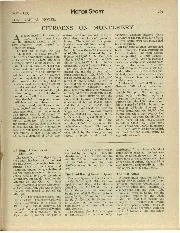

CITROENS ON MONTLHERY
CONTINENTAL NOTES. CITROENS ON MONTLHERY AS announced in last month's MOTOR SPORT two longdistance record attempts have . recently been started at Montlhery track. The first car to start was…
Sir,
I hasten to correct any misapprehension which may exist in your readers’ minds after reading Mr. C. L. Wills’ remarks on the Riley Twelve in “Cars I Have Owned” in the February issue.
Whatever caused his troubles with No. 1 big-end bearing, it was not a fault of the breed in general, I am sure. I know a number of owners and ex-owners of these grand old cars, in addition to my own 1925 car, and it is the first I have heard of it.
I am unable to understand his remarks about the white metal being run direct into the con.-rod, either. I have, among my bits and pieces, 1925, 1926 and 1928 crank assemblies and all these have detachable bronze or brass shells.
If I had to pick on one feature of the Riley side-valve engine, it would be its indestructibility. Perhaps, Mr. Wills, the No. 1 oil-feed hole to the big-end was obstructed.
I was also interested to see the Hampton radiator adorning an A.C.-engined G.N. It seems to be an exact replica of the extremely leaky component on my 1919/20 Hampton, still in the course of a very leisurely rebuild. Can someone put MC in touch with the owner, please? There may be more bits where that radiator came from.
While on the subject of Hamptons, Mr Editor, may I take up a little more of your space?
These cars were made here in Stroud and I am trying to gather together material for a little history of the firm. There were a number of personalities connected with them, about whom I would welcome information. Some of the names are: Messrs. William Paddon, Gerald Dixon, J. W. Leno, M. Daniel and his father, Sir J. Daniel. There was also a Captain Hunter, who drove an early post-war model in the M.C.C. trials with some success about 1923. Any information about these people which would be relevant to my history would be very welcome.
Personal experiences of owners of Hamptons would also be of interest, as I hope to deposit a copy of the completed history in the local museum, and the addition of a few personal touches brings life to otherwise dry facts.
I would like to know of any Hamptons or parts thereof which still exist. Excluding my own, there are two cars in the V.S.C.C., one at Weybridge and one at Horsham, both Meadows-engined coupés of the late ‘twenties. I did track down the last Hampton of all, a straight-eight (DG 5009), but it has now been lost again! This car was built by the ex-works manager, after Hamptons closed down, from parts bought at the winding-up sale. He ran it from 1932 to the time of his death during the war.
I am. Yours, etc.,
A. M. Williamson – Stroud.